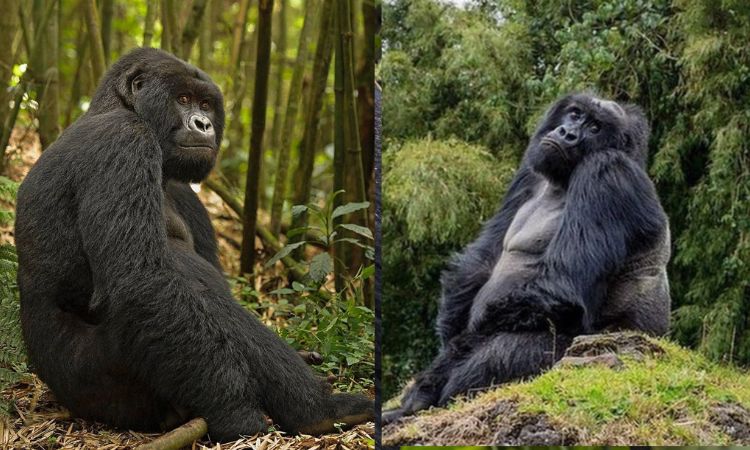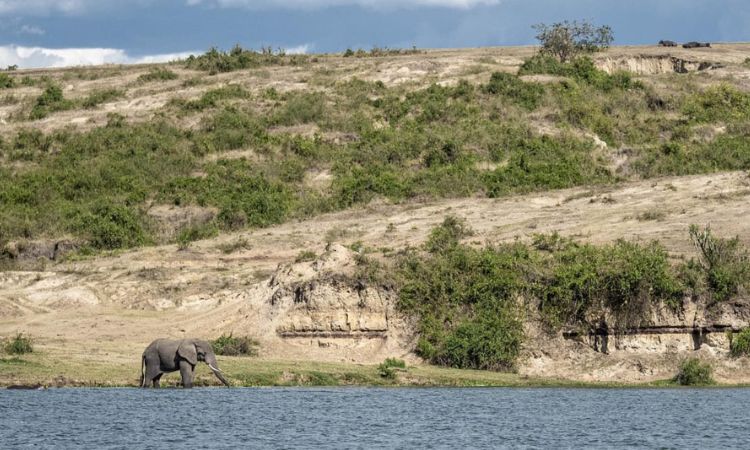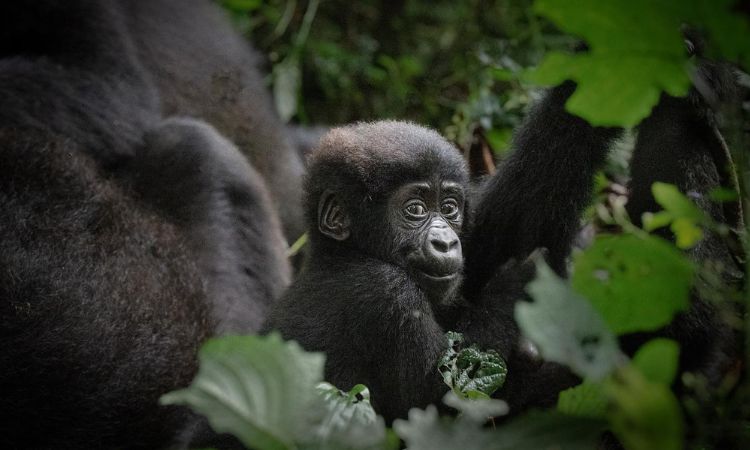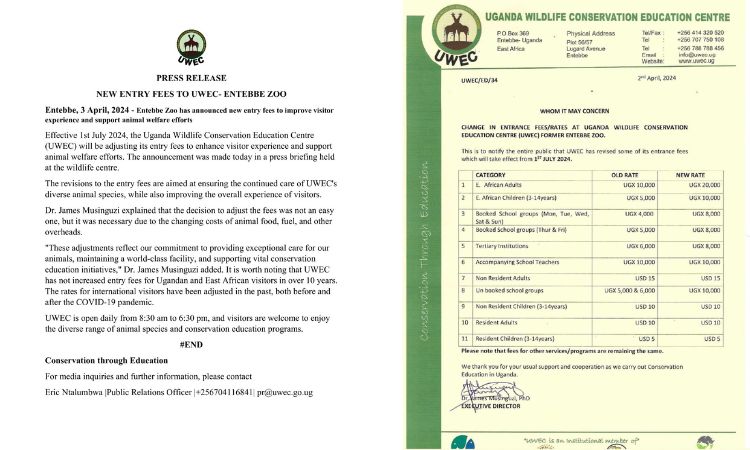Blackback Gorilla vs Silverback: 7 Incredible Facts
Blackback Gorilla vs Silverback: Learn the key differences between blackback and silverback gorillas—from size, role, and strength to family leadership. Meet them on a gorilla trekking safari with us at All Uganda Safaris.
When trekking through the misty forests of Uganda or Rwanda, you may notice that gorilla troops include adult males with distinct appearances: some with dark fur, others with a striking silvery saddle.
These are blackback and silverback gorillas, respectively, and their differences go far beyond fur color. The comparison of blackback gorilla vs silverback is a popular topic among wildlife enthusiasts, as it sheds light on the fascinating social structure of mountain gorillas.
In this guide, we explore the physical, behavioral, and social distinctions between blackback and silverback gorillas, their roles in the troop, and how you can witness these majestic creatures in the wild.
What Is a Blackback Gorilla?
A blackback gorilla is a young adult male gorilla, typically aged between 8 and 12 years. At this stage, the male has not yet developed the characteristic silver hair that distinguishes a mature silverback.
Blackbacks are physically strong and robust but remain subordinate to the dominant silverback in their troop. Their fur is entirely black, giving them their name, and they are in a transitional phase of development, preparing for potential leadership roles in the future.
In a gorilla troop, blackbacks play supportive roles. They assist the silverback in protecting the group from external threats, such as rival males or predators, and help maintain order among juveniles.
While they are sexually mature, blackbacks rarely mate, as the dominant silverback holds exclusive mating rights with the females in the troop.
Blackbacks are essentially the “apprentices” of the gorilla world, learning the skills needed to lead a troop as they grow.
What Is a Silverback Gorilla?
A silverback gorilla is a fully mature male, typically aged 12 years or older, who has developed a distinctive patch of silver-gray hair across his back and hips.
This silver saddle is a sign of maturity and dominance, marking the male as the leader of his troop. Silverbacks are the decision-makers, protectors, and primary breeders in their group, responsible for guiding the troop to food sources, resolving conflicts, and defending against threats.
The silverback’s role is critical to the survival of the troop. Weighing up to 180 kg (400 lbs) and capable of lifting over 10 times their body weight, silverbacks are formidable figures.
Their leadership is not just about strength but also about maintaining social harmony, ensuring the safety of females and infants, and asserting dominance over younger males like blackbacks.
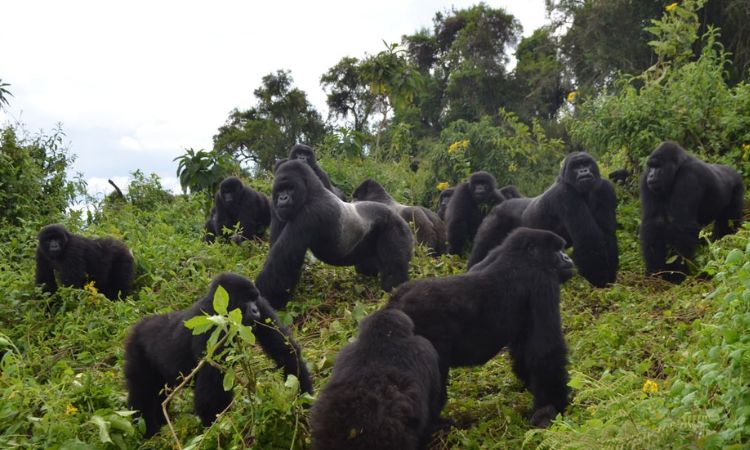
Blackback vs Silverback: Main Differences
The differences between blackback and silverback gorillas are rooted in age, physical appearance, and social responsibilities. Below is a clear comparison to highlight these distinctions:
|
Feature |
Blackback Gorilla |
Silverback Gorilla |
|
Age |
8–12 years |
12+ years |
|
Hair Color |
Entirely black |
Silver-gray saddle on back |
|
Role in Troop |
Sub-adult male, supportive role |
Dominant leader and protector |
|
Behavior |
Playful, obedient to silverback |
Protective, assertive, decision-maker |
|
Mating Rights |
None, subordinate to silverback |
Exclusive mating with females |
|
Physical Build |
Strong, less muscular |
Heavily built, larger head and chest |
|
Leadership |
Follows the silverback |
Leads and controls the troop |
This table illustrates that while blackbacks are strong and capable, silverbacks hold the ultimate authority within the troop.
The transition from blackback to silverback is a significant milestone in a male gorilla’s life, marked by physical and behavioral changes.
Social Roles in a Gorilla Troop: Blackback Gorilla vs Silverback
Gorilla troops are highly structured, with a clear dominance hierarchy that ensures group cohesion and survival. The silverback is the undisputed leader, making decisions about where the troop travels, forages, and rests. He also protects the group from external threats, such as leopards or rival males, and mediates disputes among group members.
Blackbacks, as younger males, serve as secondary protectors. They may assist the silverback in defending the troop or take on roles like supervising juveniles during play.
While they lack the authority to mate or lead, blackbacks are essential to the troop’s stability, especially in larger groups where multiple males are present.
Females in the troop focus on nurturing infants and maintaining social bonds, while juveniles and infants learn essential survival skills through play and observation.
In some cases, a troop may include multiple blackbacks, which strengthens the group’s defense but can lead to tension as these males mature and vie for dominance.
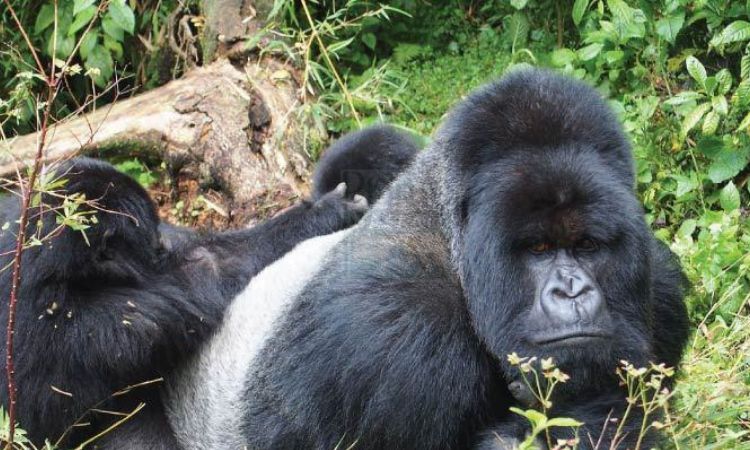
When Blackbacks Challenge Silverbacks
As blackbacks approach maturity (around 12–15 years), they may challenge the dominant silverback for control of the troop. These challenges are displays of strength and dominance, often involving chest-beating, vocalizations, and physical posturing. While fights can be intense, they rarely result in serious injury, as gorillas prefer to avoid fatal conflicts.
If a blackback successfully defeats the silverback, he may take over the troop and begin mating with the females. However, many blackbacks choose to leave their natal troop to form their own group, attracting females from other troops. This dispersal helps prevent inbreeding and promotes genetic diversity among gorilla populations.
Physical Strength Comparison
Silverbacks are significantly stronger and more robust than blackbacks. A mature silverback can weigh up to 180 kg (400 lbs) and has a muscular build, with a broad chest and large head.
Their strength is legendary—they can lift objects weighing over 800 kg (1,800 lbs), equivalent to the weight of a small car. This power is used primarily for defense, such as fending off rival males or predators, rather than aggression within the troop.
Blackbacks, while strong, are not as heavily built. They typically weigh less (around 120–150 kg) and lack the fully developed musculature of a silverback.
Their strength is used for supportive tasks, such as climbing trees or assisting in group defense, but they are no match for a silverback in a direct confrontation.
Blackback to Silverback Transformation
The transformation from blackback to silverback is a gradual process driven by hormonal changes. Around the age of 12, a blackback begins to develop the silver-gray hair that marks maturity.
This physical change is accompanied by behavioral shifts, as the male becomes more assertive and responsible. He may start practicing leadership skills, such as protecting younger members of the troop or mediating minor disputes.
The transition is not just physical but also social. A blackback must prove his strength and capability to either take over an existing troop or form a new one.
This process can take years, and not all blackbacks become silverbacks, as some remain subordinate or leave to live solitary lives.
Where to See Blackback and Silverback Gorillas
The best places to observe blackback and silverback gorillas in the wild are in the lush forests of East Africa. Top destinations include:
- Bwindi Impenetrable National Park, Uganda: Home to nearly half of the world’s mountain gorilla population.
- Mgahinga Gorilla National Park, Uganda: A smaller but stunning location for gorilla trekking.
- Volcanoes National Park, Rwanda: Famous for its conservation efforts and scenic beauty.
- Virunga National Park, Democratic Republic of Congo: Offers unique gorilla trekking experiences.
Gorilla trekking tours provide a rare opportunity to witness the dynamics between blackbacks and silverbacks in their natural habitat. These tours are highly regulated to protect the gorillas and ensure sustainable tourism.
Conservation and Eco-Tourism
Mountain gorillas are critically endangered, with fewer than 1,100 individuals remaining in the wild. Threats like habitat loss, poaching, and disease continue to challenge their survival.
Responsible tourism through gorilla trekking plays a vital role in conservation, providing funds for park rangers, anti-poaching patrols, and community development.
In Uganda and Rwanda, gorilla trekking revenue supports habitat protection and local livelihoods, ensuring that these magnificent creatures thrive for future generations. By choosing ethical tour operators like us at All Uganda Safaris, visitors contribute directly to gorilla conservation.
Frequently Asked Questions
What age does a blackback gorilla become a silverback?
A blackback becomes a silverback around 12–15 years, when silver hair develops and they assume leadership roles.
Is a blackback gorilla male or female?
Blackback gorillas are always male, typically aged 8–12 years, before maturing into silverbacks.
Can a troop have more than one silverback?
Yes, some troops have multiple silverbacks, but one is always dominant, while others are subordinate.
Who is stronger—blackback or silverback gorilla?
Silverbacks are stronger, with greater muscle mass and the ability to lift over 800 kg, compared to the less robust blackbacks.
Conclusion: Witness Blackbacks and Silverbacks in the Wild
The comparison of blackback gorilla vs silverback reveals the intricate social structure of gorilla troops, where young males grow into powerful leaders. Blackbacks represent the future, while silverbacks embody strength and responsibility.
Observing these dynamics in the wild is a transformative experience that highlights the beauty and complexity of gorilla society.
Embark on a gorilla trekking adventure with us today to see blackbacks and silverbacks in Uganda’s Bwindi or Mgahinga National Parks. Book your unforgettable journey today and witness nature’s most remarkable family dynamics up close!
